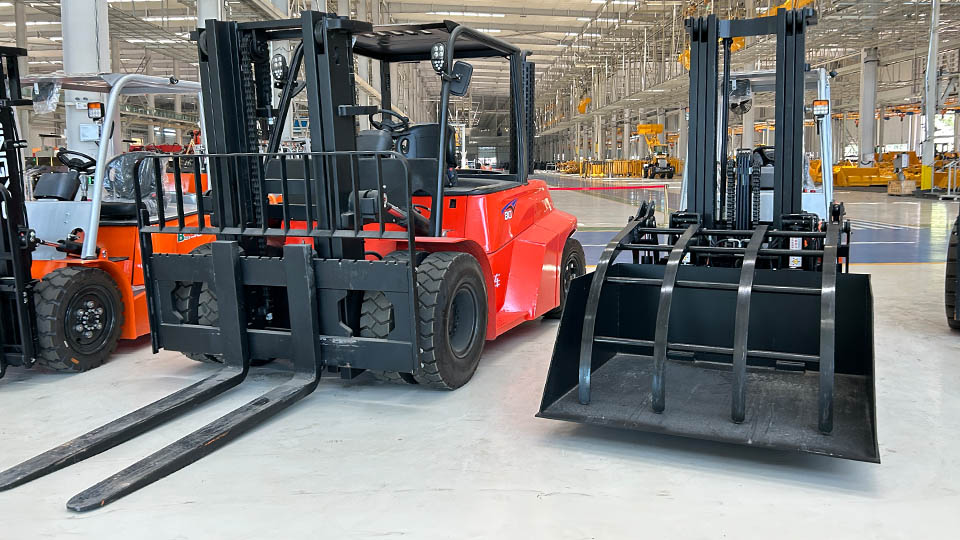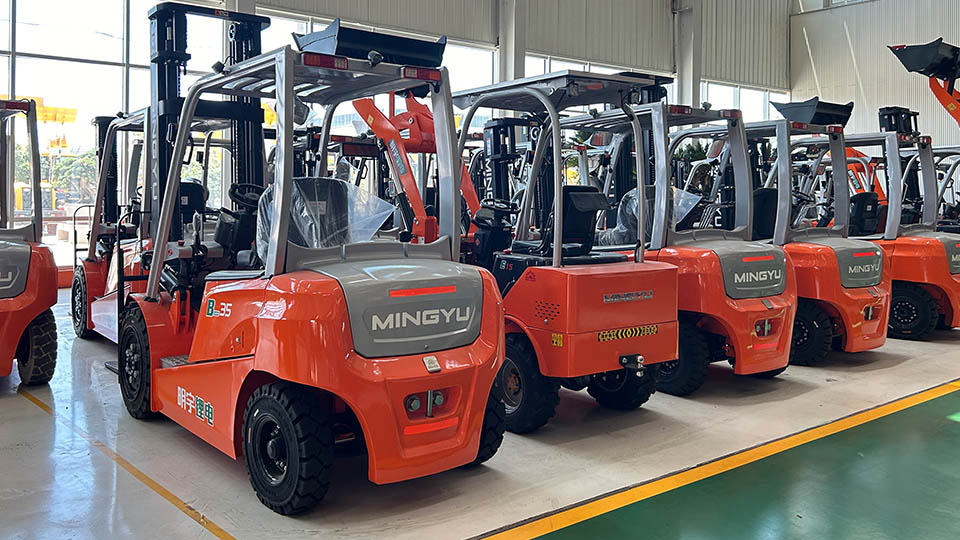
At first glance, a propane tank for a backyard BBQ grill might look similar to one powering a forklift. Both are typically cylindrical, contain liquefied petroleum gas (LPG), and share a familiar valve assembly. However, to assume they are interchangeable would be a dangerous and costly misconception. Forklift propane tanks are indeed significantly different, designed and engineered specifically for the demanding environment and operational requirements of industrial powered lift trucks. These differences extend beyond mere aesthetics, encompassing critical aspects of safety, fuel delivery, durability, and regulatory compliance.
This article will delve into the distinct characteristics that set forklift propane tanks apart, explaining the underlying principles and the reasons behind these specialized designs.
The Core Distinction: Liquid vs. Vapor Withdrawal
The most fundamental and crucial difference between a standard BBQ propane tank and a forklift propane tank lies in how they withdraw fuel.
Vapor Withdrawal (BBQ/Residential Tanks): Most residential propane applications, like grills, patio heaters, or gas fireplaces, operate on vapor withdrawal. In these tanks, the propane is stored as a liquid, but a small amount vaporizes at the top of the tank, creating a gas. The valve on a BBQ tank is designed to draw this gaseous vapor directly from the top of the cylinder. As vapor is drawn off, more liquid propane boils and turns into gas, maintaining pressure as long as there's liquid in the tank and the ambient temperature is sufficient for vaporization. This is suitable for applications with relatively low and intermittent fuel demands.
Liquid Withdrawal (Forklift Tanks): Forklift engines, being internal combustion engines, require a continuous and robust supply of fuel to generate power. To achieve this, forklift propane tanks are designed for liquid withdrawal. This means they draw liquid propane directly from the bottom of the tank. Inside the tank, a "dip tube" or "liquid withdrawal tube" extends from the service valve down to the bottom of the cylinder, allowing the liquid to be drawn out.

Once the liquid propane exits the tank, it enters a component on the forklift called a vaporizer or converter. This device heats the liquid propane, causing it to rapidly flash into a gaseous state. This instantaneous vaporization is crucial because:
* High Fuel Flow: Liquid propane, when vaporized, expands significantly (up to 270 times its liquid volume). Drawing liquid ensures that the engine receives a consistently high volume of fuel vapor, even under heavy loads or high RPMs, which a vapor withdrawal system simply couldn't provide.
* Consistent Performance: Relying on ambient vaporization in a standard tank would lead to inconsistent engine performance, especially in colder temperatures or during sustained high power output, as the rate of vaporization would fluctuate. The forklift's dedicated vaporizer ensures a controlled and consistent fuel supply regardless of external conditions.
* Fuel Efficiency: By utilizing the latent heat of vaporization in a controlled manner, the forklift's engine system is optimized for propane combustion, leading to better fuel efficiency.
Physical Design and Features
Beyond the liquid vs. vapor withdrawal mechanism, forklift propane tanks incorporate several distinct physical design features to meet the demands of industrial use:
Orientation:
Horizontal or Vertical Mounting: Forklift propane tanks are uniquely designed to operate efficiently whether mounted horizontally or vertically. Many forklifts use a horizontal mounting cradle at the rear of the vehicle. To accommodate this, forklift tanks often have two alignment pins or a specific mounting collar that ensures the tank is correctly oriented. This is critical because the liquid withdrawal tube must always be submerged in liquid propane for proper fuel delivery. If a liquid withdrawal tank is oriented incorrectly, the dip tube might draw vapor or air, causing the engine to stall or run erratically. BBQ tanks, on the other hand, are designed for vertical orientation only.
Roll Pins/Locating Pins: To ensure correct orientation, especially in horizontal mounts, forklift tanks feature small "roll pins" on their collar. These pins align with specific slots on the forklift's tank bracket, preventing incorrect installation and ensuring the liquid withdrawal tube is properly positioned.
Robust Construction:
Material: While both steel and aluminum tanks are available for forklifts, they are generally built to be more robust than residential tanks. They are designed to withstand the vibrations, bumps, and occasional impacts inherent in a demanding industrial environment. Aluminum tanks are lighter, reducing operator strain during tank changes, while steel tanks offer exceptional durability.
Collar and Foot Ring: Forklift tanks feature heavy-duty collars that protect the valves from damage during handling, transport, and operation. The foot ring is also reinforced to provide a stable base and withstand repeated placing and removal.
Valves and Fittings:
Service Valve with Dip Tube: As discussed, the service valve on a forklift tank is designed to connect to the liquid withdrawal tube.
Pressure Relief Valve: All propane tanks have a pressure relief valve, which is a critical safety device that automatically vents propane vapor if the internal pressure exceeds a safe limit (e.g., due to excessive heat). On forklift tanks, these valves are often designed to be less susceptible to damage from impacts due to the tank's operational environment.
Fixed Liquid Level Gauge (Bleeder Valve/Fill Valve): This small valve, often called a "bleeder valve," is used during filling to indicate when the tank has reached its maximum safe fill level (typically 80% liquid capacity to allow for thermal expansion). When liquid propane starts escaping from this valve during filling, it signals that the tank is adequately filled.
Overfill Prevention Device (OPD): While common on residential tanks, OPDs are also present on forklift tanks. They are designed to prevent overfilling beyond 80% capacity, a critical safety feature to avoid hydrostatic rupture if the liquid expands due to temperature increases.

Quick-Disconnect Couplings: Forklifts often use quick-disconnect couplings on their fuel lines, allowing for rapid and secure tank changes. The tank's service valve is designed to interface seamlessly with these specific couplings.
Size and Capacity:
Common Sizes: While various sizes exist, the most common forklift propane tank sizes are 33.5 lb (approximately 8 gallons) and 43.5 lb (approximately 10 gallons). These sizes are optimized for forklift run times and ease of manual handling. Residential tanks are typically 20 lb.
Weight Considerations: A full 33.5 lb forklift tank weighs around 70-75 lbs, which is manageable for one person to lift and maneuver, though many operations use hand trucks or overhead hoists for safety and ergonomics.
Safety and Regulatory Standards
The distinct design of forklift propane tanks is not merely for convenience; it's heavily influenced by stringent safety regulations and industry standards. Organizations like the Occupational Safety and Health Administration (OSHA) in the US, along with various national and international codes (e.g., NFPA 58, ANSI/UL 110), dictate the design, construction, testing, and handling of these cylinders.
Key safety considerations driving these differences include:
DOT Compliance: Forklift propane tanks are generally regulated by the Department of Transportation (DOT) for transportation and by OSHA for workplace use. They must be manufactured to specific DOT specifications (e.g., DOT-4BA240 for steel, DOT-4E240 for aluminum) which specify pressure ratings, material thickness, welding standards, and testing procedures.
Requalification (Hydrotesting): Propane tanks, including those for forklifts, have a limited service life before requiring requalification (often called hydrotesting). This process, mandated by regulations, involves inspecting the tank for damage and testing its structural integrity under pressure. This ensures that even older tanks remain safe for continued use. The typical requalification period for DOT cylinders is 5 or 10 years, depending on the tank material and inspection method.
Safe Handling and Storage: The design features like robust collars and alignment pins contribute to safer handling during tank changes and storage. Additionally, specific OSHA guidelines exist for the indoor and outdoor storage of forklift propane tanks, addressing ventilation, distance from ignition sources, and protection from damage.
The Impact of Differences on Operations
Understanding these differences is paramount for safe and efficient forklift operations:
Never Interchange Tanks: Attempting to use a standard BBQ propane tank on a forklift is extremely dangerous and could lead to:
Engine Starvation: A vapor withdrawal tank cannot supply enough fuel to an internal combustion engine under load, leading to stalling or very poor performance.
Fire/Explosion Hazard: Improper connections or forcing an incompatible tank could lead to leaks of highly flammable liquid propane, creating a significant fire or explosion risk.
Damage to Equipment: The forklift's fuel system is designed for liquid withdrawal; using a vapor withdrawal tank can damage components like the vaporizer/converter.
Regulatory Violations: Using unauthorized equipment is a violation of safety regulations, leading to fines and potential shutdowns.
Proper Orientation is Key: Operators must always ensure the forklift tank is correctly oriented in its cradle, aligning the pins. Incorrect orientation means the liquid withdrawal tube won't be submerged, leading to fuel delivery issues.
Regular Inspections: Daily pre-shift inspections must include the propane tank, checking for dents, rust, leaks, and damage to valves or connections. The legible recertification date is also critical.
Trained Personnel: Only properly trained and authorized personnel should handle, change, and store forklift propane tanks. This includes understanding the risks of cold burns from liquid propane, fire hazards, and proper PPE.
Conclusion
While both BBQ and forklift propane tanks contain the same fuel, their engineering philosophies diverge significantly to meet vastly different demands. The forklift propane tank, with its liquid withdrawal system, robust construction, specialized valves, and precise mounting features, is a highly engineered component essential for the safety, efficiency, and continuous operation of propane-powered forklifts in demanding industrial environments. Recognizing and respecting these crucial differences is not just a matter of technical understanding but a fundamental aspect of maintaining a safe and productive workplace.
Name: selena
Mobile:+86-13176910558
Tel:+86-0535-2090977
Whatsapp:8613181602336
Email:vip@mingyuforklift.com
Add:Xiaqiu Town, Laizhou, Yantai City, Shandong Province, China